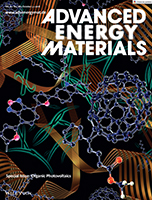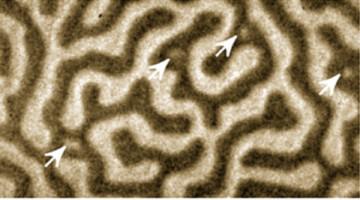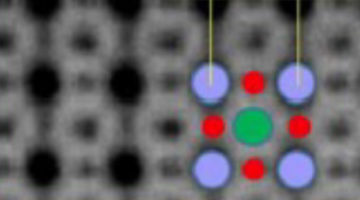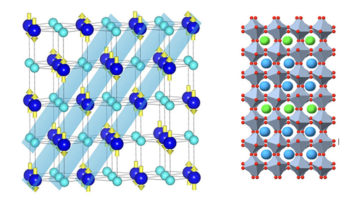In this article, Ye et al. present the determination of liquidus miscibility and its temperature dependence of organic films by scanning transmission x‐ray microscopy and outline an approach to convert liquidus miscibility to an effective Flory‐Huggins interaction parameter χ, which will pave a way to predict morphology and processing strategies of polymer solar cells. Read more »
Ordered Magnetic Patterns in a Disordered Magnetic Material
Scientists have confirmed the presence of chirality, or handedness, in nanometers-thick samples of amorphous (noncrystalline) multilayer materials. The chirality—which potentially could be exploited to transmit and store data in a new way—was observed in the domain walls between neighboring regions of opposite spin. Read more »
Pupa Gilbert to Receive the 2018 Shirley Award
Pupa Gilbert, professor of physics at the University of Wisconsin at Madison, is the 2018 recipient of the David A. Shirley Award for Outstanding Scientific Achievement at the ALS, “for her development of polarization-dependent imaging contrast mapping to image the orientation of carbonate nanocrystals in marine biominerals.” Read more »
Clues to the Solar System’s Original “Bricks and Mortar”
In comet dust, researchers discovered composite organic-inorganic mineral grains that are likely to be the original “bricks and mortar” of the solar system. “Forensic” samples preserved from the birth of the solar system allow investigations into the nature of the atomic and molecular ancestry of the terrestrial planets and life on Earth. Read more »![]()
![]()
A 2D Lattice of Molecular Qubits for Quantum Computing
Researchers developed a way to build a 2D lattice of molecular-spin qubits (quantum bits of information), with control over qubit orientation and localization. The work enables the integration of molecular quantum-information hardware into the scalable, robust, solid-state architectures needed for performing quantum computation. Read more »![]()
![]()
Structure Reveals Mechanism Behind Periodic Paralysis
X-ray crystallography of a membrane protein provided a structural understanding of how a single mutation can result in periodic muscle paralysis. The results suggest possible drug designs that could provide relief to patients with a genetic disorder that causes them to be overcome suddenly with profound muscle weakness. Read more »![]()
![]()
Oxygen Vacancies Matter in the LaNiO3 Metal–Insulator Transition
Electronic structure measurements using x-ray absorption spectroscopy suggest that oxygen vacancies contribute to the metal–insulator transition in ultrathin films of LaNiO3. The results give scientists another “knob” to turn to tune this important transition, which could be useful for making advanced electronic devices. Read more »
Infrared Beams Show Cell Types in a Different Light
By shining highly focused infrared light on living cells, scientists hope to unmask individual cell identities and to diagnose whether the cells are diseased or healthy. Their focus is on developing a rapid, noninvasive way to easily identify cell types and features within living cells, to aid in biological and medical research. Read more »
Graphene-Based Catalyst Improves Peroxide Production
Scientists characterized a graphene-based electrocatalyst that potentially makes the production of hydrogen peroxide more selective, efficient, and cost effective. Hydrogen peroxide is an important commodity chemical with growing demand in many areas, including the electronics industry, wastewater treatment, and paper recycling. Read more »![]()
![]()
A Designed Material Untangles Long-Standing Puzzle
The origin of the metal-to-insulator transition in a key material system was revealed by nanostructures designed to decouple simultaneous phase transitions. This approach could lead to new materials with emergent physics and unique electronic properties, supporting broader research efforts to revolutionize modern electronics. Read more »![]()
![]()
- « Previous Page
- 1
- …
- 58
- 59
- 60
- 61
- 62
- …
- 83
- Next Page »









